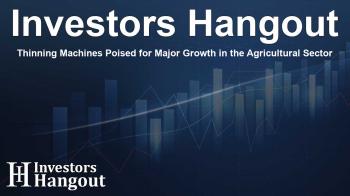Thinning Machines Poised for Major Growth in the Agricultural Sector

Global Thinning Machine Market Overview
The thinning machine market is entering a transformative phase, currently valued at approximately $2.1 billion. Projections indicate that this sector is poised to expand at a commendable CAGR of 6.1%, reaching around $3.8 billion by 2034. This surge is significantly influenced by the increasing demand for precision agriculture and innovative automation as farmers seek to enhance efficiency amidst labor shortages.
Market Segmentation by Product Types
The thinning machine product segment can be broadly categorized into three major types:
- Automatic Thinning Machines: These hold a substantial ~55% market share, favored by large-scale agricultural operations for their efficiency in labor cost reduction.
- Semi-Automatic Thinning Machines: Making up about ~20% of the market, these are tailored for mid-sized farms, striking a balance between cost and operational efficiency.
- Manual Thinning Machines: With ~25% market share, these machines remain a popular choice for small-scale farmers, especially in developing regions where affordability is a concern.
Applications and Market Demand
Thinning machines serve a diverse array of applications:
- Agriculture: Comprising 45% of market revenue, agricultural applications typically involve crop management techniques aimed at yield improvements through precision tools.
- Horticulture: Accounting for about 30% of the market, the rising trend of urban gardening and organic farming significantly propels demand.
- Greenhouse Cultivation: This segment is burgeoning and represents around 15% of market activity, focusing on tailored equipment for controlled agriculture.
- Forestry: Comprising 10%, this market segment is expanding due to sustainable forestry practices being adopted globally.
Regional Insights and Trends
The adoption and growth of thinning machines differ significantly across regions:
Asia-Pacific: The Leading Market
- The Asia-Pacific region commands the largest market share, accounting for about 40%. Rapid population growth and the subsequent need for sustainable food production drive the industry's expansion.
- Active government initiatives promote agricultural modernization, fostering the adoption of automation and precision farming technologies.
- Technological innovation hubs in countries like Japan and China enhance R&D in farming equipment, improving access to advanced technologies.
North America: A Stable Market
- With approximately 25% of the market share, North America emphasizes sustainability in agriculture, making it a pivotal region for thinning machine growth.
- Robust infrastructure and tech adoption enable farmers to rapidly integrate IoT and automation in their practices.
Drivers of Market Growth
Need for Precision Agriculture
The increasing pressure on global food production necessitates the adoption of precision agriculture techniques. This approach not only minimizes waste but also enhances crop yield, thus driving the demand for thinning implements.
Automation and Labor Shortages
Labor shortages in agriculture due to rural to urban migration are compelling farmers to employ automated solutions. Thinning technologies are particularly effective at creating more efficient farming operations without being constrained by labor availability.
Challenges the Market Faces
High Initial Investment
Though the long-term benefits are substantial, the upfront costs associated with advanced thinning technology can be prohibitive for small and medium-sized farms. Financial investments in automation need to be justified by clear operational gains.
Technical Expertise Requirements
Utilizing sophisticated thinning machinery requires skilled personnel. The gap between the need for qualified operators and their availability in rural areas can hinder growth.
Future Outlook
The thinning machine market is set for substantial future growth as the agricultural sector continues to evolve towards greater sustainability and technological integration. Ongoing innovations will likely enhance the market's potential, addressing challenges while meeting increasing agricultural demands globally.
Frequently Asked Questions
What is the current value of the thinning machine market?
The thinning machine market is currently valued at approximately $2.1 billion.
What factors are driving the market growth?
The key drivers include the need for precision agriculture, labor shortages, and the integration of automation technologies.
What types of thinning machines are available?
There are three main types: automatic, semi-automatic, and manual thinning machines.
Which region has the largest market share?
Asia-Pacific holds the largest market share, accounting for about 40% of the global thinning machine market.
What challenges does the thinning machine market face?
Challenges include high initial investment costs and a shortage of skilled operators necessary to operate advanced machinery.
About The Author
Contact Kelly Martin privately here. Or send an email with ATTN: Kelly Martin as the subject to contact@investorshangout.com.
About Investors Hangout
Investors Hangout is a leading online stock forum for financial discussion and learning, offering a wide range of free tools and resources. It draws in traders of all levels, who exchange market knowledge, investigate trading tactics, and keep an eye on industry developments in real time. Featuring financial articles, stock message boards, quotes, charts, company profiles, and live news updates. Through cooperative learning and a wealth of informational resources, it helps users from novices creating their first portfolios to experts honing their techniques. Join Investors Hangout today: https://investorshangout.com/
The content of this article is based on factual, publicly available information and does not represent legal, financial, or investment advice. Investors Hangout does not offer financial advice, and the author is not a licensed financial advisor. Consult a qualified advisor before making any financial or investment decisions based on this article. This article should not be considered advice to purchase, sell, or hold any securities or other investments. If any of the material provided here is inaccurate, please contact us for corrections.

